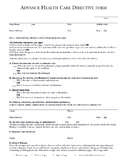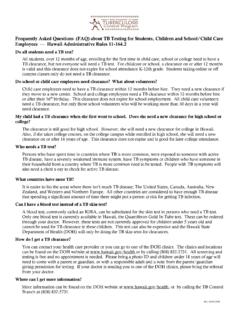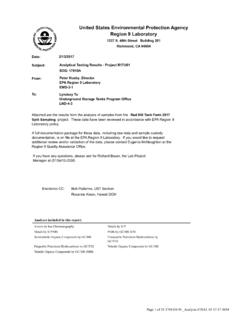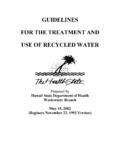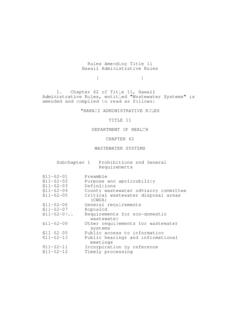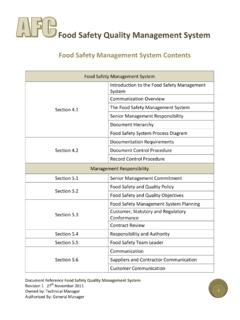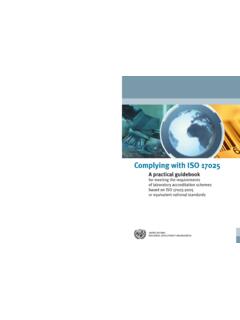Transcription of Chlorine Testing DPD Method - Hawaii Department of Health
1 Chlorine RESIDUAL Testing FOR DRINKING WATER SYSTEMS USING DPD COLORIMETRIC TEST KITSINTRODUCTION3/6/2017 Chlorine Residual Testing The one chemical analysis that operators/samplers in all public water systems perform. Water and wastewater operators perform it. How do you make sure you are getting accurate and reliable results? State must approve the use of DPD colorimetric test kits to measure residual concentrations of Chlorine , chloramines, and Chlorine dioxide. 3/6/2017 DPD Colorimetric Method - Overview Colorimetric Analysis The use of a colored reagent to determine the concentration of a contaminant This is a colorimetric version of the DPD Method DPD = N,N-diethyl-p-phenylenediamine Method most used by water operators (it is relatively easy to perform)3/6/2017 DPD Colorimetric Method While it is a simple Method , it is important to perform the tests properly. Too often it seems that operators hurry and take shortcuts. This leads to inaccurate and unreliable Systems A quality system should be in place to ensure the quality and reliability of your results.
2 This consists of both Quality Assurance and Quality Assurance Quality Assurance Your plan for determining the quality of data from internal and external quality control measures. Basically it answers who, how, why, when, and what. The quality assurance plan can be quite large and highly Assurance Plan Cover Sheet with Approvals Quality policy Statement Organizational Structure Staff Responsibilities Analyst training and performance Tests performed by the laboratory Handling and receipt of samples Sample control and documentation traceability of measurement Major Equipment, Instrumentation, and Reference Standards Used Standard Operating Procedures (SOP) Approval and Control of Procedures Procurement of Reference Materials and Supplies Procurement of Subcontractors Services Internal QC Activities Calibration, Verification, and Maintenance of Instrumentation Audits and Reviews Corrective Action Departure from Documented Policies And so Assurance Plan Cover Sheet with Approvals Quality policy Statement Organizational Structure Staff Responsibilities Analyst training and performance Tests performed by the laboratory Handling and receipt of samples Sample control and documentation traceability of measurement Major Equipment, Instrumentation, and Reference Standards Used Standard Operating Procedures (SOP)
3 Approval and Control of Procedures Procurement of Reference Materials and Supplies Procurement of Subcontractors Services Internal QC Activities Calibration, Verification, and Maintenance of Instrumentation Audits and Reviews Corrective Action Departure from Documented Policies And so All of the items mentioned in the prior slides are REQUIRED FOR CERTIFIED LABS. As a small system only analyzing Chlorine residuals, applicability of items is totally dependent on your local public Health official. We will look at those items in bold type, as they should be part of your of measurement You should be using certified materials while performing your analyses. Verify this by obtaining a Certificate of Analysis from the manufacturer. This will connect your measurements back to a national or international QC Activities Quality Control QC This is the actual procedure that provides the support for your results A little math, a little statistics, and a little Each test Method has a list of required QC elements3/6/2017 Standard Operating Procedures A Standard Operating Procedure (SOP) can address all the bold items.
4 This SOP can serve as you quality assurance plan. We will discuss some items that should be in a DPD Method SOP3/6/2017 OBJECTIVES/GOALS OF TODAY S TRAINING Provide Attendees with an understanding of the history of water chlorination, water system requirements for measuring residual Chlorine (disinfectant), conducting Chlorine residual measurement tests, QA/QC activities to ensure accurate and reliable results. Assist the water systems in preparing a quality system to ensure the quality and reliability of your results. Provide necessary training that leads to state approval of the use of DPD colorimetric test kits. 3/6/20173/6/2017 OVERVIEW OF WATERDISINFECTION Water Disinfection and History of Chlorination Chemicals Used in Chlorination Chlorine Disinfection Chemistry What is Chlorine Residual (Total, Combined, Free?3/6/2017 OVERVIEW OF WATER DISINFECTIONW ater Disinfection and the History of Chlorination Chlorine discovered in Sweden (1744). Identified as a chemical element in 1810.)
5 Chlorine and Chlorine -containing products evaluated and demonstrated to be effective disinfectants. 3/6/2017 OVERVIEW OF WATER DISINFECTIONW ater Disinfection and the History of Chlorination Disinfection of water practiced for millenniums. Historical records show that boiling of water was recommended (as early as 500 ). Earliest record of Chlorine used for disinfection was in Louiville, Kentucky in 1896. Used in 1897 in England to sterilize water-distribution main after a typhoid OF WATER DISINFECTIONW ater Disinfection and the History of Chlorination First continuous use in Belgium (1902) to the purpose of aiding coagulation and making water biologically safe. First continuous use in America for municipal application to water was in 1908. To disinfect a 40-mgd reservoir supply for the Jersey City, NJ water utility. Paved way for Chlorine s rapid extension and use by other public water RESIDUAL Testing FOR DRINKING WATER SAMPLINGC hlorination may produce adverse effects.
6 Taste and odor characteristics of phenols and other organic compounds present in a water supply may be intensified. Potentially carcinogenic chloroorganiccompounds such as chloroform may be fulfill the primary purpose of chlorination and to minimize any adverse effects, it is essential that proper Testing procedures be used with a foreknowledge of the limitations of the analytical OF WATER DISINFECTIONC hemicals Used in Chlorination Elemental Chlorine , Cl2 Hypochlorite- Calcium Hypochlorite, Ca(OCl)2- Sodium Hypochlorite, NaOCl3/6/2017 Chlorine Most Frequently Used Disinfectant Hydrochloric and Hypochlorous Acid formed when added to water Exist in Water as Free, Total, and Combined Available3/6/2017 Chlorine CHEMISTRY Chlorine is added to water as Chlorine gas or as sodium or calcium Gas:Cl2+ H2O HOCl+ H++ Cl-Sodium Hypochorite:NaOCl+ H2O Na++ HOCl+ OH-3/6/2017 Chlorine CHEMISTRY The two chemical species formed by Chlorine in water are hypochlorousacid and hypochlorite ion.
7 HOCl H++ OCl-HypochlorousAcid Hypochlorite Ion3/6/2017 Chlorine CHEMISTRY Hypochlorousacid is the stronger disinfectant. Below pH free Chlorine exists predominantlyin the HOClform. Above pH free Chlorine exist predominantly in the Chemistry & Disinfection Efficiency:Free Chlorination:Cl2 + H2O HOCl+ OCl-(strong)|Chloramination:|NHCl2 + HOCl H2O + NCl3|decreasing NH2Cl + HOCl H2O + NHCl2|disinfectionNH3 + HOCl H2O + NH2Cl|efficiency|Organic Amines: Org. N + HOCl OrgN-Cl(~none)3/6/2017 OVERVIEW OF WATER DISINFECTIONWhat is Chlorine Residual (total, combined, free, ..) Total: The sum of free and combined available forms of Chlorine . Combined: Chloramines including monochloramines, dichloramines, and nitrogen trichloride. (combined available) Free: Chlorine existing in water as hypochlorous acid or the hypochlorite ion. (free available)3/6/20173/6/2017 WHY/WHEN DO WE CONDUCT Chlorine RESIDUAL MEASUREMENTS? Total Coliform Rule/Groundwater Rule Disinfectant/Disinfection By-Product Rule Surface Water Treatment Rule Drinking Water Compliance Monitoring System Repair/Maintenance Emergency Situations/Events3/6/2017 WHY DO WE NEED TO CONDUCT Chlorine RESIDUAL ANALYSISRTCR-Determine water dechlorinationrequirement.
8 -Requires Chlorine residual monitoring under the D/DBPR at the same and time and place as Coliformmonitoring (routine and repeat). System (General)RTCR3/6/2017 WHY DO WE NEED TO CONDUCT Chlorine RESIDUAL ANALYSISGWR-Ensure proper concentration of residual Chlorine as required by Groundwater Rule. SUGGESTED minimum of source samples. Ensure that source samples are raw water and not treated water when required to collected triggered source PointsRaw Groundwater Source3/6/2017 WHY DO WE NEED TO CONDUCT Chlorine RESIDUAL ANALYSISD/DBPR Determine Chlorine level and potential generation of disinfection by-products (THM & HAA5) Determine residual disinfectant in water. Determine requirements for DO WE NEED TO CONDUCT Chlorine RESIDUAL ANALYSISDDBPRD rinking Water Requirements for Chlorine Residual (c) Disinfectant residuals.(1) Systems must measure residual disinfectant concentrations of free Chlorine , combined Chlorine (chloramines), and Chlorine dioxide by the methods listed in the following table:3/6/2017 WHY DO WE NEED TO CONDUCT Chlorine RESIDUAL ANALYSISDDBPRAPPROVED METHODS FOR DISINFECTANT RESIDUAL COMPLIANCE MONITORINGM ethodologyStandard MethodASTM methodResidual Measured1 Free ClCombined ClTo t a l ClClO2 AmperometricTitration4500-Cl DD 1253-86 XXXLow Level AmperometricTitration4500-Cl EXDPD Ferrous Titration4500-Cl FXXXDPD Colorimetric4500-Cl GXXXS yringaldazine (FACTS)4500-Cl HXIodometricElectrode4500-Cl IXDPD4500-Cl O2 DXAmperometricMethod II4500-ClO2 DX1 X indicates Method is approved for measuring specified disinfectant DO WE NEED TO CONDUCT Chlorine RESIDUAL ANALYSISDDBPR(2) If approved by the State, systems may also measure residual concentration for Chlorine , chloramines, and Chlorine dioxide by using DPD colorimetric test kits.
9 (3) A party approved by EPA of the State must measure residual disinfectant DO WE NEED TO CONDUCT Chlorine RESIDUAL (h) Requirements for States to adopt 40 CFR Part 141, subpart addition to the general primacy requirements elsewhere in this part, including the requirements that State regulations be at least as stringent as federal requirements, an application for approval of the State program revision that adopts 40 CFR 141, subpart L, must contain a description of how the State will accomplish the following program requirements: 3/6/2017 WHY DO WE NEED TO CONDUCT Chlorine RESIDUAL ANALYSISD/DBPR(3)Section (c) of this chapter (DPD colorimetric test kits). Approve DPD colorimetric test kits for free and total Chlorine measurements. State approval granted under (a)(2) of this chapter for the use of DPD colorimetric test kits for free Chlorine Testing is acceptable for the use of DPD test kits in measuring free Chlorine residuals as required in 40 CFR part 141, subpart DO WE NEED TO CONDUCT Chlorine RESIDUAL ANALYSISD/DBPR(4) Section (c)(3) and (d) of this chapter (State approval of parties to conduct analyses).
10 Approve parties to conduct pH, bromide, alkalinity, and residual disinfectant concentration measurements. The State s process for approving parties performing water quality measurements for systems subject to 40 CFR part 141, subpart H requirements in paragraph (b)(2)(i)(D) of this section may be used for approving parties measuring water quality parameters for systems subject to DO WE NEED TO CONDUCT Chlorine RESIDUAL ANALYSISSTATE APPROVAL PROCESS FOR USE OF DPD COLORIMETRICTEST KITS FOR RESIDUAL DISINFECTANT MEASUREMENT3/6/2017 Point of Average Residence TimeDDBPRTTHMHAA5 Disinfectant Residual3/6/2017 Point of Maximum Residence TimeDDBPRTTHMHAA5 Disinfectant Residual3/6/2017 WHY DO WE NEED TO CONDUCT Chlorine RESIDUAL ANALYSISS urface Water Treatment Rule Requires Chlorine residual monitoring to determine contact time and Entry Points to distribution system monitoring. DO WE NEED TO CONDUCT Chlorine RESIDUAL ANALYSISC hemical Monitoring Determine requirements for dechlorination.

